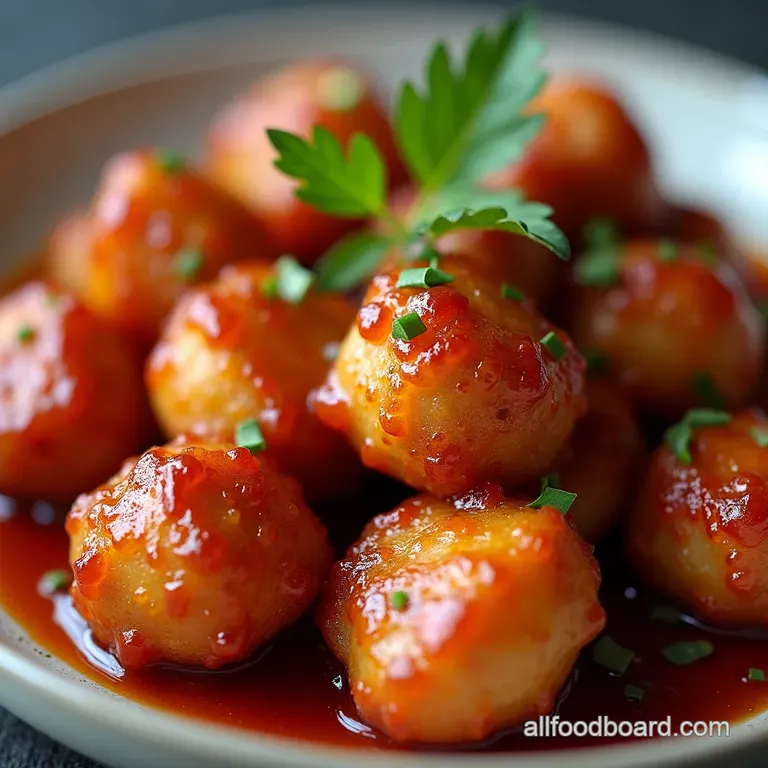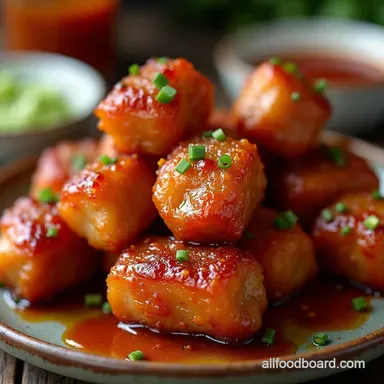Sticky Spicy and Seriously Addictive Crispy Gochujang Glazed Pork Belly Bites

- Unveiling the Ultimate Korean Pub Snack: Gochujang Pork Belly Bites
- Why This Recipe Delivers Unforgettable Flavor Depth
- Assembling the Core Components for Perfect Pork Belly
- Phase One: Rendering Fat and Achieving Pork Perfection
- Mastering the Sticky Glaze Application
- Serving Suggestions and Creative Pairings
- Tips for Troubleshooting and Storing Leftovers
- Recipe FAQs
Crispy Gochujang Pork Belly

Ingredients:
Instructions:
Nutrition Facts
Unveiling the Ultimate Korean Pub Snack: Gochujang Pork Belly Bites
There are few culinary experiences as deeply satisfying as perfectly prepared pork belly. When that unctuous richness meets the complex, vibrant spice of Korean fermented chili paste, you enter a flavour dimension reserved for the truly indulgent. We are diving deep into the creation of Gochujang Pork Belly Bites , a recipe that transforms simple ingredients into an irresistible appetizer or main course feature. These morsels are tender at their core, boasting a melting texture achieved through slow cooking, followed by a fiery, sticky glaze that locks in flavour and provides a satisfyingly crisp exterior. Forget complicated techniques; we are crafting Asian Pork Belly that hits every note—sweet, spicy, salty, and deeply savoury.
Why This Recipe Delivers Unforgettable Flavor Depth
Crafting truly exceptional Korean Pork Belly Bites isn't just about tossing meat in sauce; it’s about layering techniques to build complexity. Our approach ensures that even if you’re new to Gochujang Pork Recipes , the results will be restaurant-quality.
The Irresistible Allure of Glazed Pork Belly
The secret to these appetizers lies in the dual cooking process. We first render the fat and tenderize the meat through a gentle, slow braise, infusing the pork with aromatic spices like star anise and ginger. This initial slow cook dissolves connective tissues, making the pork incredibly yielding. Once tender, we introduce high, dry heat to achieve that essential crisp exterior. This juxtaposition of textures—soft interior giving way to a crunchy, sticky shell—is what makes these bites so addictive.
Balancing Heat, Sweetness, and Umami in Every Bite
The heart of this dish is, of course, the glaze. To create the Best Korean Pork Belly Sauce , we start with Gochujang, the deep, earthy heat source. This is tempered perfectly with honey for sweetness, soy sauce for profound umami, and a whisper of sesame oil for nutty aroma. The goal is never pure heat, but rather a beautiful harmony where the spice elevates the pork’s inherent richness, rather than overwhelming it.
Effortless Execution for Weeknight Feasts
Despite yielding such a luxurious result, the active preparation for these Gochujang Pork Belly Bites is remarkably low. After a 25-minute prep window, the oven takes over for the long, slow transformation. This means you can focus on preparing your side dishes while the pork belly achieves its fork-tender perfection, making this sophisticated flavour profile accessible even on a busy weeknight.
Assembling the Core Components for Perfect Pork Belly
To begin our journey toward these spectacular Crispy Pork Belly Bites Recipe , we need two distinct element preparations: the foundation (the pork) and the flavour bomb (the glaze). We’ll start by sourcing and preparing the meat itself, which is arguably the most crucial step in how to marinate pork belly gochujang style—though here, we braise it first for unmatched tenderness.
Sourcing Premium Pork Belly: Cut and Preparation Tips
For this recipe, you will need about 2 lbs of pork belly, cut into uniform 1.5-inch cubes. Skin-on or skinless works, but if you choose skin-on, be mindful that the skin needs to be removed before the final crisping stage, as it tends to dry out or burn easily under high heat. Before anything else, pat those cubes aggressively dry with paper towels. Moisture is the enemy of crispness later on, so ensure the surface is as dry as possible.
Essential Pantry Items for Authentic Korean Heat
The braising liquid sets the aromatic base. We combine 1 cup of water with 1/2 cup of soy sauce and 1/4 cup of rice vinegar. Crucially, we introduce whole aromatics: 4 smashed cloves of garlic and a 1-inch knob of ginger, thinly sliced. If you have one, a single star anise pod adds an incredible, subtle background complexity that elevates the entire profile. These ingredients infuse the meat deeply during the long soak.
The Unexpected Spice Agents You Need to Grab
The heat and defining characteristic come from the glaze ingredients. You must have genuine Gochujang (Korean chilli paste). Alongside this, gather 3 tablespoons of honey (or maple syrup for a slight variation), 2 tablespoons of soy sauce, 1 tablespoon of sesame oil, and 1 tablespoon of packed brown sugar. These elements combine to form the sticky coating that will later adhere to the crisped edges of the pork.
Specialized Equipment for Maximum Crispiness
While a simple baking dish can manage the braise, you need a heavy-bottomed, oven-safe pot, like a Dutch oven, for the initial cooking phase. Following the braise, a large skillet or cast-iron pan is indispensable for the final searing and glazing stages, as it distributes high heat evenly, ensuring every side of the Gochujang Pork Belly Bites achieves that desirable crunch.
Related Recipes Worth Trying
- Easy Raspberry Brie Bites for Valentines Day Party Food — Looking for simple Valentines Day party food ideas that look gourmet These 40min Brie Raspberry Bites are buttery cheesy and perfect for grazing
- Foolproof Gochujang Shrimp Recipe Sweet Spicy Dinner in 25 Mins — Ditch the takeaway This authentic Gochujang Shrimp recipe coats plump prawns in a sticky addictive Koreaninspired sauce A perfect quick seafood dinner idea
- Rich NoBake Brownie Bites Fudgy Chocolate Treats Ready Fast — Craving something chocolatey These easy No Bake Brownies are fudgy rich and require zero oven time Perfect for quick afternoon snacks Get the foolproof...
Phase One: Rendering Fat and Achieving Pork Perfection

The first major cooking phase is dedicated to patience, allowing the pork belly to become exquisitely tender. After cubing your dry pork, place it into your Dutch oven. Pour in the braising liquids—the water, soy sauce, and rice vinegar—ensuring the aromatics are nestled amongst the cubes. Bring this mixture to a gentle simmer on the stovetop. Once simmering, cover the pot tightly and transfer it to a preheated oven set at 325° F ( 160° C). Allow this process to continue for a solid 2 to 2. 5 hours. The pork should yield easily to a fork when ready, signifying that the fat has rendered beautifully and the collagen has broken down.
Mastering the Sticky Glaze Application
While the pork rests following its long soak, it’s time to focus on that glossy coating. In a small saucepan, whisk together all the glaze components: Gochujang, honey, soy sauce, sesame oil, brown sugar, garlic powder, and black pepper. Heat this mixture gently over low heat, stirring constantly until the sugar is fully dissolved and the glaze has thickened just enough to lightly coat the back of a spoon—this usually takes about three minutes. Remember, this is a glaze, not a hard caramel; it should remain fluid enough to toss the pork effectively without scorching instantly.
Slow Cooking the Belly for Tender Results (Braising vs. Roasting)
While some Gochujang Pork Recipes might opt for dry roasting, our braising method guarantees that signature melt-in-your-mouth texture. By submerging the pork in liquid for two hours, we are essentially pressure-cooking it gently with flavour, ensuring even cooking deep into the centre of each cube before we introduce the aggressive heat needed for texture.
The Crucial Resting Period Before Glazing
Once the pork is fork-tender, carefully remove the cubes with a slotted spoon, setting them aside to cool slightly. You can drain the braising liquid or strain it; many chefs reserve a small amount of this liquid, as it can be added by the teaspoon to the glaze if it thickens too much during the heating process. Allowing the pork to cool slightly makes it much easier to handle during the searing phase.
Tossing Technique: Ensuring Even Glaze Coverage
Once the pork is seared and crispy—which we’ll cover next—the transfer to the glaze must be swift. You want every surface of the pork to be coated instantly. Have your hot, crispy pork ready near the skillet containing the warm glaze, ready for the final, decisive toss.
The High-Heat Finish: Creating That Desired Char
The transformation from tender to truly crispy happens in a large skillet over medium-high heat with a tablespoon of neutral oil. Working in batches to avoid overcrowding the pan (which causes steaming), sear the pork cubes aggressively on all sides until they develop a deep golden-brown crust. Once they are crisp, reduce the heat immediately to low, pour in your prepared glaze, and toss rapidly for just 60 to 90 seconds until every piece is glistening and coated. Speed is key here to prevent the sugars from burning.
Serving Suggestions and Creative Pairings
These Gochujang Pork Belly Bites are inherently rich, so they pair best with components that offer brightness, acidity, or a clean canvas.
Suggested Korean Side Dishes (Banchan) to Complement the Richness
The perfect accompaniment is a selection of traditional banchan . A vibrant, quick cucumber salad ( Oi Muchim ) provides necessary acidity and crunch to cut through the fat. Alternatively, a simple, sesame-dressed spinach ( Sigeumchi Namul ) offers an earthy balance. And, of course, never underestimate the power of freshly steamed white rice to soak up any lingering, glorious sauce residue.
Adjusting the Spice Level for Different Palates
If you are serving guests sensitive to heat, simply reduce the quantity of Gochujang in the glaze by half and perhaps replace that volume with a tablespoon of ketchup or tomato paste to maintain viscosity without adding too much fire. For those who crave serious heat, integrate a teaspoon of Gochugaru (Korean chilli flakes) directly into the warm glaze for an intense kick.
Tips for Troubleshooting and Storing Leftovers
Even the best recipes occasionally run into minor snags. A quick fix can save your batch of delicious pork.
Can You Air Fry These Pork Belly Morsels?
Absolutely! If you prefer an Air Fryer Gochujang Pork Belly route, the process requires a slight modification. After braising and cooling the pork, toss the cubes lightly in a teaspoon of oil and air fry at 380° F ( 195° C) for about 10- 12 minutes, shaking halfway through, until they are deeply browned and crisp. Then, toss them immediately in the warm glaze off the heat. This method often achieves a slightly drier, more uniform crispness than pan-searing.
Reheating Secrets for Maintaining Crunch
Leftovers should be stored in an airtight container in the refrigerator. To bring back the texture, avoid the microwave entirely, as it steams the exterior. Instead, reheat them in a dry, hot skillet over medium heat for a few minutes, shaking constantly until the glaze softens and the exterior crisps up once more. This quick blast of dry heat revives that satisfying crunch we worked so hard to achieve.

Recipe FAQs
Can I make these Gochujang Pork Belly Bites ahead of time? They sound a bit involved.
You absolutely can, which is grand if you're planning a proper feast! The best way is to complete steps 1 through 3 (braise and drain the pork). Once cooled, you can store the tender cubes in the fridge for up to two days. Just remember to pat them dry again before searing them up for that essential crispiness later.
My pork belly isn't getting crispy; what’s the secret to that lovely crackle?
Ah, the eternal battle for crispness! The absolute key is moisture control; the pork must be bone dry before it hits the hot oil for searing. Also, ensure your pan is properly hot—medium-high is essential—and don't overcrowd the pan, or the pork will steam instead of frying. Work in batches if you need to, like you’re queuing for the latest must-have gadget!
This recipe seems spicy! How can I turn down the heat if I’m serving family who prefer something milder than a full-on fire alarm?
That’s easily sorted. The primary heat comes from the Gochujang, so for a milder version, reduce the Gochujang in the glaze by half and substitute that volume with a tablespoon or two of tomato puree or a bit of extra honey. This will maintain the colour and stickiness without blowing everyone’s socks off with spice.
I can only find skinless pork belly; will the Gochujang Pork Belly Bites still work well?
Yes, they will still be utterly delicious! The skin is mainly there for textural interest and a bit of extra fat rendering during the long cook. If you use skinless pork belly, you might find they crisp up even faster in the final stage, so keep a very close eye on them when you add that sticky glaze!
How should I store leftovers, and can I freeze these sticky bites?
Leftovers should be kept in an airtight container in the fridge for up to three days. To reheat, the best way to revive them is in a hot oven or an air fryer for about 8-10 minutes; this brings back the crisp texture beautifully. While freezing is possible, the glaze might separate slightly upon thawing, so fresh is always best for these!